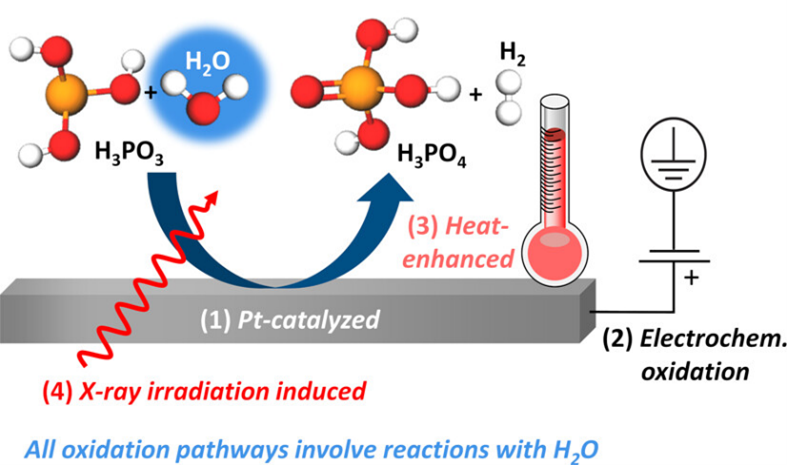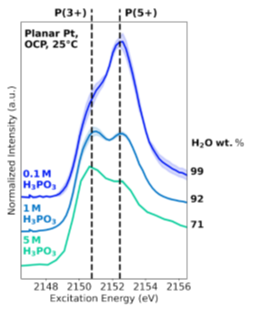Department Interface Design
Electrocatalysts for hydrogen fuel cells
Elucidating the complex oxidation behavior of phosphorus impurities at the Pt|aqueous H3PO3 interface in HT-PEMFCs by a combination of X-ray spectroscopies
High-temperature polymer electrolyte membrane fuel cells (HT-PEMFCs), using polybenzimidazole (PBI) membranes doped with phosphoric acid (H3PO4), are a promising option for micro-stationary clean electric energy. At 120°-180°C, H3PO4 can reduce during HT-PEMFC operation, forming phosphorus impurities like H3PO3, which adsorb on the Pt catalysts, hindering the HT-PEMFC performance. Therefore, studying the Pt-H3PO3 interaction and its oxidation behavior at relevant conditions (i.e. high temperatures and positive potentials) is crucial for optimizing HT-PEMFCs.
To investigate the interaction at the Pt|aqueous H3PO3 interface, in situ ambient pressure hard X-ray photoelectron spectroscopy (AP-HAXPES) was used at room temperature and open circuit potential (OCP). Findings show that while aqueous H3PO3 is stable in its tetrahedral tautomeric form for at least a week, when in contact with Pt, it very quickly oxidizes via H2O to form H3PO4 and H2. This work opens up a new paradigm regarding the generation (and removal) of impurities in HT-PEMFC, since H3PO3 could be directly oxidized on the cathodic Pt catalyst. However, conditions closer to actual HT-PEMFC operation were needed to understand better this mechanism and its impact in the performance of the device.
Therefore, we designed an electrochemical cell capable of reaching high temperatures relevant to fuel cell operation and compatible with XANES measurements at the OÆSE endstation at BESSY-II. Using electrocatalysts with different active platinum surfaces (a flat electrode prepared by sputtering and a rough electrode prepared by in situ electrodeposition on Pt), we employed in situ XANES measurements at the P K-edge in the EMIL-beamline to verify the catalytic ability of Pt for the oxidation of H3PO3 in an aqueous medium under various conditions relevant to HT-PEMFC, such as high temperatures, applied potential, electrolyte flow, etc. The experiments confirmed that Pt is catalyzing the chemical oxidation of H3PO3 to H3PO4, and that it is enhanced upon applying positive potentials to the Pt electrode and by raising the electrolyte temperature; the latter being corroborated by complementary ion exchange chromatography (IEC) measurements (see a summary in Fig. 1). Notably, all these oxidation processes involve reactions with H2O, as further supported by XANES measurements of aqueous H3PO3 with different H2O concentrations see (Fig. 2). This result of this work supports the possibility of re-oxidizing impurities during the operation of the fuel cell by dosing H2O vapor and opens new possibilities for increasing the lifespan of HT-PEMFCs.
More information:
Wibowo, R. E.; Garcia-Diez, R.; Bystron, T.; van der Merwe, M.; Prokop, M.; Arce, M. D.; Efimenko, A.; Steigert, A.; Bernauer, M.; Wilks, R. G.; Bouzek, K.; Bär, M. Elucidating the Complex Oxidation Behavior of Aqueous H3PO3 on Pt Electrodes via in situ Tender X-ray Absorption Near Edge Structure Spectroscopy at the P K-edge. J. Am. Chem. Soc., 2024, 146 (11), 7386–7399. https://doi.org/10.1021/jacs.3c12381
Wibowo, R. E.; Garcia-Diez, R.; Bystron, T.; Prokop, M.; van der Merwe, M.; Arce, M. D.; Jiménez, C. E.; Hsieh, T.-E.; Frisch, J.; Steigert, A.; Favaro, M.; Starr, D. E.; Wilks, R. G.; Bouzek, K.; Bär, M. Oxidation of Aqueous Phosphorous Acid Electrolyte in Contact with Pt Studied by X-Ray Photoemission Spectroscopy. ACS Appl. Mater. Interfaces, 2023, 15 (44), 51989–51999. https://doi.org/10.1021/acsami.3c12557
Wibowo, R. E.; Garcia-Diez, R.; van der Merwe, M.; Duarte-Ruiz, D.; Ha, Y.; Félix, R.; Efimenko, A.; Bystron, T.; Prokop, M.; Wilks, R. G.; Bouzek, K.; Yang, W.; Cocchi, C.; Bär, M. Core-Level Spectroscopy with Hard and Soft X-Rays on Phosphorus-Containing Compounds for Energy Conversion and Storage. J. Phys. Chem. C, 2023, 127 (42), 20582–20593. https://doi.org/10.1021/acs.jpcc.3c04704




